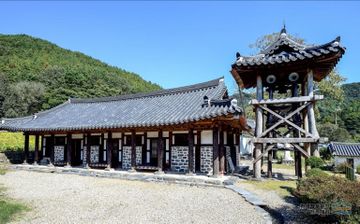되재성당지
| 되재성당지 Doejae Catholic Church Site |
|
 되재성당지, 디지털완주문화대전, 한국학중앙연구원. |
|
| 대표명칭 | 되재성당지 |
|---|---|
| 영문명칭 | Doejae Catholic Church Site |
| 한자 | 升峙聖堂地 |
| 주소 | 전라북도 완주군 화산면 승치리 729-1 |
| 지정(등록) 종목 | 전라북도 기념물 제119호 |
| 지정(등록)일 | 2004년 7월 30일 |
| 분류 | 유적건조물/종교신앙/천주교/성당 |
| 수량/면적 | 일원(5,355㎡) |
| 웹사이트 | 되재성당지, 국가문화유산포털, 문화재청. |
해설문
국문
되재성당은 1895년에 세워진 최초의 한옥성당으로, 서울 약현성당에 이어 두 번째로 지어진 성당이다.
초기 성당의 모습은 제8대 조선대목구장이었던 뮈텔주교(Gustave Charles Marie Mutel)의 일기에 그려진 도면과 제1대 대구대목구장 드망즈주교(Florian Demange)가 찍은 사진 자료 등을 통해 확인할 수 있는데, 바실리카 교회건축양식을 한식목구조에 적용한 한옥성당이었다. 단층 한식 목구조 건물로 기와를 얹은 팔작집이었으며 평면은 장방형인데 제단과 출입구를 나란히 배치하여 제단을 향하는 공간의 깊이를 확보하였다. 또한 남녀를 구분하는 당시 풍습에 따라 출입문을 따로내고 내부 중앙에 가림막을 설치하였다. 성당의 부재는 논산 쌍계사의 부재를 사용하였다. 이처럼 되재성당은 서양 문화가 한국에 들어와 정착하는 과정을 보여주는 중요한 기념물이다. 그러나 초기 성당 건물은 한국전쟁 때 소실되었고, 그 자리에 1954년 공소 건물을 새로 세웠다가 2006년 복원사업을 통해 일부 복원되었다. 성당 구내에는 성당 외에 사제관과 기술학교인 태극계명학교 등이 있었고, 성당 뒤편에는 전라도에서 활동했던 두 명의 프랑스 선교사 묘가 있다.
영문
Doejaeseongdang Catholic Church Site
Doejae Catholic Church was established in 1895. It was the second Catholic church built in Korea, after Yakhyeon Catholic Church was built in 1892 in Seoul. It was also the first Catholic church to be built in a traditional Korean style.
The church was destroyed during the Korean War (1950-1953), and in 1954, a chapel-of-ease was built on its former site. The current building, built in 2006, is a reconstruction of the original church.
The original building’s design was confirmed through drawings of its plans found in the diaries of Gustave Charles Marie Mutel (1854-1933), the 8th vicar apostolic of Korea, as well as through photographs taken by Florian Demange (1875-1938), the 1st vicar apostolic of Daegu. The single-story building with a tile hip-and-gable roof applied the layout of a Christian basilica to a Korean-style wooden structure. It featured a rectangular layout with the main altar and the main entrance facing one another on the opposite ends of the building. This unconventional layout maximized the space facing the altar. To uphold the Confucian principle of separation of the sexes, wooden partitions were installed down the center of the church to create left and right aisles for men and women, respectively, that were accessed by separate doors. These features make Doejae Catholic Church a valuable example of the process by which Western culture was adopted in Korea.
Apart from the church building, the complex includes a presbytery and a vocational school. Behind the church building are the tombs of two French priests who evangelized in the Jeolla-do region, namely Fr. Josse (1851-1886) and Fr. Lafourcade (1860-1888).
영문 해설 내용
1895년에 세워진 되재성당은 1892년에 지어진 서울 약현성당에 이어 한국에서 두 번째로 지어진 성당이다. 또한 한국 최초로 한옥 건물로 지어진 성당이기도 하다.
원래의 건물은 한국전쟁 때 소실되었고, 그 자리에 1954년 공소 건물을 새로 세웠다. 지금의 성당 건물은 2006년 원래의 모습에 따라 복원된 것이다.
원래 건물의 모습은 제8대 조선대목구장이었던 뮈텔주교(1854-1933)의 일기에 그려진 도면과 제1대 대구대목구장 드망즈 주교(1875-1938)가 찍은 사진 자료 등을 통해 확인할 수 있었다. 바실리카 교회건축양식을 한식 목조 구조에 적용한 건물이었으며, 단층 건물에 기와를 얹은 팔작지붕을 얹었다. 평면은 장방형이며, 제단과 출입구를 건물 양끝에 서로 마주보게 배치하여 제단을 향하는 공간의 깊이를 확보하였다. 또한 남녀를 구분하는 당시 풍습에 따라 성당 내부 중앙에는 나무벽을 설치해서 왼쪽과 오른쪽 공간을 각각 남자와 여자가 사용하도록 하였다. 이처럼 되재성당은 서양 문화가 한국에 들어와 정착하는 과정을 보여주는 중요한 건물이다.
경내에는 성당 외에도 사제관과 기술학교 등이 있었다. 현재 성당 뒤편에는 전라도 지역에서 사목했던 두 명의 프랑스 신부 조스(1851-1886)와 라푸르카드(1860-1888)의 묘소가 있다.